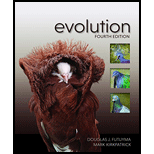
Concept explainers
To explain: The criteria or measurements for the better adaptability of the population after a certain evolutionary change.
Introduction: Adaption is a natural phenomenon and it is a distinguishing character of the organisms that are evolved by natural selection. Therefore, adaption is also an evolutionary process. Over time, organisms alter their characters to adapt to certain changes in the environment.
Explanation of Solution
Evolution is a process which results in some heritable changes in the population. These changes may be caused by many factors and one of them is natural selection. Evolution leads to the adaption of certain characters by the organism. An organism is said to be better adapted if the characters adapted after evolution are more fit than the previous generation. For example, wings of penguin are adapted to swimming in water which is a beneficial feature for penguins. Natural selection is one of the main reasons for better adaptability among the population.
For measurement of adaptability, it is important to first understand about the function of the feature that whether the feature makes the organism more fit with respect to survival and reproduction or not.
Better adaptability after evolution can be measured on the basis of efficient accomplishment of certain functions in the organism which was not possible before. After evolution, the organism becomes more fit in reproduction and survival.
Criteria or methods that explain that some organisms are better adapted after evolution are:
- Complexity:
With evolution, the character becomes more complex to perform various functions, because the complexity of any organs is dependent on the process of natural selection. Therefore, understanding the level of complexity in various organisms can help in understanding their evolutionary pattern.
- Design:
The design of any organ of the organism can be due to adaptation to the surrounding environment. For example, the plants living in the hot conditions, have designed their leaves in the form of leaflets as an adaptation to conserve loss of water. Therefore, understanding the design of any organ helps in understanding the evolutionary changes.
- Experiments:
The experiments done by the organisms to change some functions of the organs helps them to adapt better as compared to the other members of the group that do not experiment. For example, various plants have shifted from bird pollination to insect pollination that helped them in surviving more as compared to others.
- Comparative method:
It is a very significant method to compare the adaptive significance of any feature. By analyzing the evolutionary trend of a feature in previous generations, it is easy to identify the improved function of that feature. This helps in understanding the adaptability function of those organs.
Hence, evolutionary changes that increase the fitness of the organism by increasing the chances of survival and reproduction rate are important factors which explain that the population is better adapted after evolution.
Want to see more full solutions like this?
- When beta-lactamase was isolated from Staphylcoccus aureus and treated with a phosphorylating agent, only the active site, serine was phosphorylated. Additionally, the serine was found to constitute 0.35% (by weight) of this beta-lactamase enzyme. Using this, calculate the molecular weight of this enzyme and estimate the number of amino acids present in the polypeptide.arrow_forwardBased on your results from the Mannitol Salt Agar (MSA) media, which of your bacteria were mannitol fermenters and which were not mannitol fermenters?arrow_forwardhelp tutor pleasearrow_forward
- Q8. A researcher wants to study the effectiveness of a pill intended to reduce stomach heartburn in pregnant women. The researcher chooses randomly 400 women to participate in this experiment for 9 months of their pregnancy period. They all need to have the same diet. The researcher designs two groups of 200 participants: One group take the real medication intended to reduce heartburn, while the other group take placebo medication. In this study what are: Independent variable: Dependent variable: Control variable: Experimental group: " Control group: If the participants do not know who is consuming the real pills and who is consuming the sugar pills. This study is It happens that 40% of the participants do not find the treatment helpful and drop out after 6 months. The researcher throws out the data from subjects that drop out. What type of bias is there in this study? If the company who makes the medication funds this research, what type of bias might exist in this research work?arrow_forwardHow do I determine the inhertiance pattern from the pedigree diagram?arrow_forwardits an open book assignemntarrow_forward
- Describe two different gene regulation mechanisms involving methylationarrow_forwardWhat is behavioral adaptarrow_forward22. Which of the following mutant proteins is expected to have a dominant negative effect when over- expressed in normal cells? a. mutant PI3-kinase that lacks the SH2 domain but retains the kinase function b. mutant Grb2 protein that cannot bind to RTK c. mutant RTK that lacks the extracellular domain d. mutant PDK that has the PH domain but lost the kinase function e. all of the abovearrow_forward
 Human Biology (MindTap Course List)BiologyISBN:9781305112100Author:Cecie Starr, Beverly McMillanPublisher:Cengage Learning
Human Biology (MindTap Course List)BiologyISBN:9781305112100Author:Cecie Starr, Beverly McMillanPublisher:Cengage Learning Concepts of BiologyBiologyISBN:9781938168116Author:Samantha Fowler, Rebecca Roush, James WisePublisher:OpenStax College
Concepts of BiologyBiologyISBN:9781938168116Author:Samantha Fowler, Rebecca Roush, James WisePublisher:OpenStax College Human Heredity: Principles and Issues (MindTap Co...BiologyISBN:9781305251052Author:Michael CummingsPublisher:Cengage Learning
Human Heredity: Principles and Issues (MindTap Co...BiologyISBN:9781305251052Author:Michael CummingsPublisher:Cengage Learning Biology (MindTap Course List)BiologyISBN:9781337392938Author:Eldra Solomon, Charles Martin, Diana W. Martin, Linda R. BergPublisher:Cengage Learning
Biology (MindTap Course List)BiologyISBN:9781337392938Author:Eldra Solomon, Charles Martin, Diana W. Martin, Linda R. BergPublisher:Cengage Learning Biology: The Dynamic Science (MindTap Course List)BiologyISBN:9781305389892Author:Peter J. Russell, Paul E. Hertz, Beverly McMillanPublisher:Cengage Learning
Biology: The Dynamic Science (MindTap Course List)BiologyISBN:9781305389892Author:Peter J. Russell, Paul E. Hertz, Beverly McMillanPublisher:Cengage Learning





